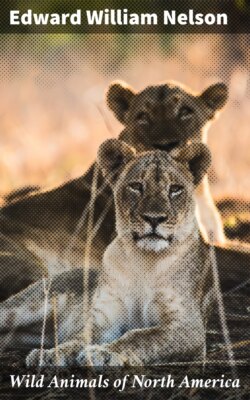Читать книгу Wild Animals of North America - Edward William Nelson - Страница 32
На сайте Литреса книга снята с продажи.
GRAY, OR TIMBER, WOLF (Canis nubilus and its relatives)
ОглавлениеTable of Contents
Large wolves, closely related to those of Europe and Siberia, once infested practically all of Arctic and temperate North America, excepting only the arid desert plains. This range extended from the remotest northern lands beyond 83 degrees of latitude south to the mountains about the Valley of Mexico.
When America was first colonized by white men, wolves were numerous everywhere in proportion to the great abundance of game animals. With the increased occupation of the continent and the destruction of most of its large game, wolves have entirely disappeared from large parts of their former domain. They still occur in varying numbers in the forest along our northern border from Michigan westward, and south along the Rocky Mountains and the Sierra Madre to Durango, Mexico, and also in all the Gulf States.
The variations in climate and other physical conditions within their range has resulted in the development of numerous geographic races, and perhaps of species, of wolves, which show marked differences in size and color. The white Arctic wolf, described on pages 421 and 424, is one of the most notable of these, but the gray wolf of the Rocky Mountain region and the eastern United States is the best known.
Since the dawn of history Old World wolves, when hunger pressed, have not hesitated to attack men, and in wild districts have become a fearful scourge. American wolves have rarely shown this fearlessness toward man, probably owing to the abundance of game before the advent of white men and to the general use of firearms among the pioneers. That wolves are extremely difficult to exterminate is shown by their persistence to the present day in parts of France and elsewhere in Europe. This is due both to their fecundity (they have from eight to twelve young), and to their keen intelligence, which they so often pit successfully against the wiles of their chief enemy—man.
Gray wolves appear to mate permanently, and in spring their young are born in natural dens among great rocks, or in a burrow dug for the purpose in a hillside. There both parents exercise the greatest vigilance for the protection of the young. The male kills and brings in game and stands guard in the neighborhood, while the mother devotes most of her time to the pups while they are very small. At other times of year packs made up of one or more pairs and their young hunt together with a mutual helpfulness in pursuing and bringing down their prey that shows a high order of intelligence. Wolves are in fact first cousins of the dog, whose mental ability is recognized by all.
During the existence of the great buffalo herds, packs of big gray “buffalo wolves” roamed the western plains, taking toll wherever it pleased them. Since these vast game herds have disappeared only a small fraction of the wolves have survived. There are enough, however, not only to commit great ravages among the deer and other game in northern Michigan and on the coastal islands of Alaska, but also to destroy much live stock in the Rocky Mountain region.
THE PEARY CARIBOU
One of the geographic forms of the Barren Ground Caribou (see text, page 460). ARCTIC WOLF
So serious have the losses in cattle and sheep on the ranges become that Congress has recently made large appropriations for the destruction of wolves and other predatory animals, and these disturbers of the peace will soon become much reduced in numbers. The necessity for action of this kind is shown by the recent capture in Colorado of a huge old dog wolf with a definite record of having killed about $3,000 worth of stock. Interesting as wolves are, filling their place in the wilderness, their habits bar them from being tolerated in civilized regions.
GRAY, OR TIMBER, WOLF BLACK WOLF
PLAINS COYOTE, OR PRAIRIE WOLF
ARIZONA, OR MEARNS, COYOTE
